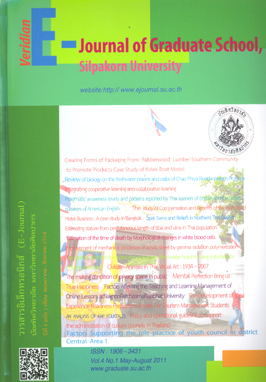การพัฒนารูปแบบการนิเทศการสอนตามแนวคิดของกลิ๊กแมน เพื่อพัฒนาสมรรถภาพการจัดการเรียนรู้ด้านทักษะการอ่านของครูภาษาไทย
Main Article Content
บทคัดย่อ
บทคัดย่อ
การวิจัยครั้งนี้มีวัตถุประสงค์เพื่อพัฒนารูปแบบการนิเทศการสอนตามแนวคิดของกลิ๊กแมนเพื่อ พัฒนาสมรรถภาพการจัดการเรียนรู้ด้านทักษะการอ่านของครูภาษาไทย และเพื่อตรวจสอบคุณภาพของ รูปแบบ การนิเทศการสอน ด้วยกระบวนการวิจัยและพัฒนา (Research and Development) ร่วมกับ แนวคิดการออกแบบการสอนเชิงระบบ (Instructional System Design) ประกอบด้วย 4 ขั้นตอน คือ 1) ศึกษา วิเคราะห์ ข้อมูลพื้นฐานของ การนิเทศการสอน 2) ออกแบบและพัฒนารูปแบบการนิเทศการสอน 3) นำรูปแบบการนิเทศ การสอนไปใช้ และ 4) ประเมินผลรูปแบบการนิเทศการสอน ประชากร คือครู ภาษาไทย ชั้น ประถมศึกษาปีที่ 4 – 6 จำนวน 565 คน กลุ่มตัวอย่างคือ ครูภาษาไทย จำนวน 5 คน ได้มาโดยการเลือกแบบเจาะจง (Purposive Sampling) และนักเรียนชั้นประถมศึกษาปีที่ 4 – 6 จำนวน 166 คน เครื่องมือที่ใช้ในการวิจัย ได้แก่ แบบวิเคราะห์เนื้อหา แบบสัมภาษณ์ แบบบันทึกการสังเกต แบบทดสอบ แบบสอบถาม แบบบันทึก การจัดการเรียนรู้แบบพรรณนาความ (Journal Writing) แบบ ประเมิน และการสนทนากลุ่ม สถิติที่ใช้ในการวิเคราะห์ข้อมูล ได้แก่ ค่าร้อยละ (%) ค่าเฉลี่ย () ส่วน เบี่ยงเบนมาตรฐาน (S.D.) การทดสอบค่าที (t ) และการวิเคราะห์เนื้อหา (Content Analysis)
ผลการวิจัยพบว่า รูปแบบการนิเทศการสอนตามแนวคิดของกลิ๊กแมน เพื่อพัฒนาสมรรถภาพ การจัดการเรียนรู้ด้านทักษะการอ่านของครูภาษาไทย ที่เรียกว่า “AIPDE Model” ประกอบด้วย กระบวนการดำเนินงาน 5 ขั้น คือ ขั้นที่ 1 การประเมินสภาพและสมรรถนะในการทำงาน (Assessing : A) ขั้นที่ 2 การให้ความรู้ก่อนการนิเทศ (Information : I) ขั้นที่ 3 การวางแผนการนิเทศ (Planning : P) ขั้นที่ 4 การปฏิบัติ การนิเทศ (Doing : D) ประกอบด้วยกระบวนการนิเทศการสอน 3 ขั้นคือ 1) การ ประชุมก่อนการสังเกตการสอน 2) การสังเกตการสอน 3) การประชุมให้ข้อมูลย้อนกลับหลังการสังเกตการสอน และขั้นที่ 5 การประเมินผลการนิเทศ (Evaluating : E) ผลจากการตรวจสอบคุณภาพของรูปแบบการ นิเทศการสอนโดยผู้เชี่ยวชาญ 6 คน พบว่า รูปแบบการนิเทศการสอนมีคุณภาพ และผลจากการตรวจสอบ ประสิทธิผลของรูปแบบการนิเทศการสอนโดยการนำไปใช้ ในโรงเรียน พบว่า ครูผู้ทำหน้าที่นิเทศมีสมรรถภาพ การนิเทศการสอนหลังการใช้รูปแบบการนิเทศการสอนสูงกว่าก่อนการใช้รูปแบบการนิเทศการสอน ครูผู้รับ การนิเทศมีสมรรถภาพการจัดการเรียนรู้ด้านทักษะการอ่านหลังการใช้รูปแบบการนิเทศการสอนสูงกว่าก่อน การใช้รูปแบบการนิเทศการสอน นักเรียนมีทักษะการอ่านหลังเรียนสูงกว่าก่อนเรียน อย่างมีนัยสำคัญทาง สถิติที่ระดับ 0.05 นักเรียนมีพัฒนาการด้านพฤติกรรมการเรียนรู้แบบร่วมมือกันสูงขึ้น ครูผู้ทำหน้าที่นิเทศ และครูผู้รับการนิเทศมีความพึงพอใจต่อรูปแบบการนิเทศการสอน อยู่ในระดับมากที่สุด และนักเรียนมีความ พึงพอใจต่อการสอนของครูภาษาไทย อยู่ในระดับมากที่สุด
ABSTRACT
The purposes of this research were to develop of instructional supervision model based on Glickman’ s principles to improve reading instructional competency of Thai language teachers and effectiveness verify the supervision model based on Glickman’s principles to improve reading instructional competency of Thai language teachers with research and development process and instructional system design. The procedure of developing this instructional supervision model was divided into 4 stages : 1) studying and analyzing the context and assessing the supervisory needs. 2) design and development of the supervision model. 3) implementing the supervision model, and 4) evaluating the supervision model. The population were 565 Thai language teachers. The respondents were 5 Thai language teachers and 166 students of fourth to sixth grade taught . The research instruments were content analysis form, interviewing form, observation form, testing form, descriptive journal writing, evaluation form and focus group . Statistics used for analyzing the data were percentage, mean, standard deviation, t-test and content analysis.
The results of the research revealed that the development of instructional supervision model based on Glickman s principals to improve reading instructional competency of Thai language teachers called “AIPDE Model” consisted of 5 stages – as follow : first stage – assessing (A), second stage - informing (I), third stage - planning (P), fourth stage – Doing (D) which composed of 3 supervision steps : 1) before teaching and supervising 2) observing classes 3) giving feedback after class-observing and fifth stage - evaluating (E). The other finding from empirically investigating of the supervision model’s efficiency by 6 experts who consistently approved that the supervision model was effective. After the implementation of the supervision model, teachers, taking a supervisor role, employed higher supervisory competencies in learning management than before the implementation of supervision model. After the implementation of the supervision model, Thai language teachers, taking a learning manager role, had higher competencies in learning management for developing students’ achievement than before the implementation of the supervision model. Students knowledge and reading skills competency were significantly higher than before the model implementation of the supervision model at the level of 0.05. Cooperative Learning behavior of the students were improve . Five Thai language teachers, as supervisors and learner managers, were mutually satisfied with this supervision model at the most satisfactory level. Most students agreed with the teachers’ learning management for reading skills at the highest level.

